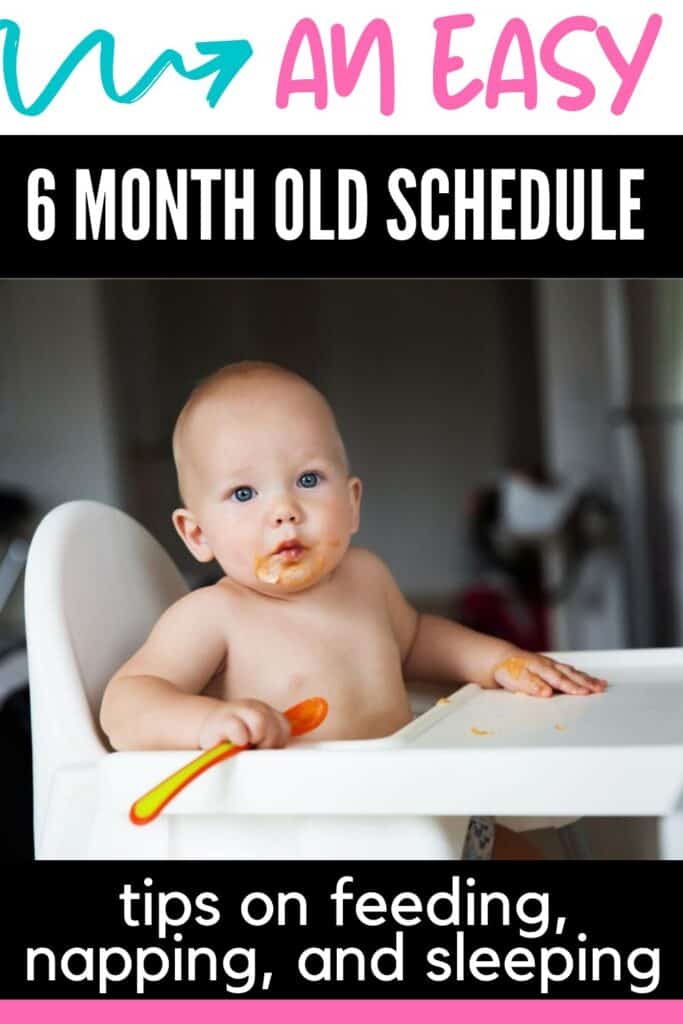Now that your little one has reached 6 months they’re more alert and active than ever before. Six months might also mean your baby gets her first taste at solids, and she might also begin sleeping through the night and possibly dropping one of her naps.
Here’s a guide to help you create a six month old schedule that will work best for your baby.

This post contains affiliate links. Read my policy here.
6 month old feeding schedule
Six months is an important milestone for many babies, as they likely have their first taste of real foods. And while introducing solid foods to your little one is certainly exciting, remember, that food before one is just for practice- so don’t stress over it.
By the time your baby reaches 6 months they are most likely consuming 6-8 ounces every 3-4 hours.
If you’re starting solids, breastfeed or bottle feed your baby before you offer solids.
Here’s a sample 6 month old baby feeding schedule:
8:00 am feed
11:00 am feed, offer solids
2:00 pm feed
5:00 pm feed, offer solids
7:00 pm feed right before bed
Note: Your routine will vary based on babies hunger cues and nap schedule. Use sample schedules as a guide, and not something that’s set in stone.
6 month old nap schedule
By 6 months, many parents are crossing their fingers hoping that their baby will soon sleep through the night.
Getting your little one on a consistent nap schedule works wonders towards making sure they sleep through the night, although it’s totally not guaranteed at this age!
The biggest mistake many parents make is keeping their baby awake too long during the day without putting them down to nap. A 6 month old wake window is 2.5 hours.
Depending on how long your little one can stay awake between naps, they’ll either take 2 or 3 naps ranging from 45 minutes to 2 hours.
Here’s a sample six month old nap schedule, given a 7:00 am wake up time.
9:00 am down for 1st nap
10:30 am up from 1st nap
12:30 pm down for 2nd nap
2:00 pm up from 2nd nap
4:00 pm down for 3rd nap
4:45 pm up from 3rd nap
Make sure your baby is up by 5 pm, or they’ll likely have a harder time falling asleep that night!
Got a bad napper on your hands? Here’s an article I wrote on sleep training for naps.
6 month old sleep schedule
Now that you’re on the other side of the dreaded 4 month sleep regression, you’re likely ready for your baby to begin sleeping longer periods throughout the night or maybe even sleeping through the night entirely.
The key to getting your baby to sleep through the night is setting up a consistent feeding and nap routine so that their little tummies are full and they’re not over-tired or overstimulated by the time bedtime rolls around.
According to the National Sleep Foundation, babies need between 10-12 hours of sleep per night. Creating a good wind down routine your baby will start to associate with night time is key to helping your little one catch some much needed z’s.
Sample bedtime routine for a 6 month old baby
6:30 pm: bath
6:45 pm: books, singing, baby massage
7:00 pm: feed
7:15 pm: books, rocking
7:30 pm: lights out
At this age, babies may begin sleeping in their own room, and parents typically find that a sound machine and black out curtains work wonders for keeping their baby to sleep despite any outside disturbances, i.e, you’d actually like to vacuum!
Additionally, sleep training is something that many parents attempt to start at 6 months– myself included! If you’re interested in starting, here’s my complete guide on the no cry sleep method.
Related: Baby sleep tips you need
Other questions you may have about your 6 month old’s schedule and routine
What if my baby rolls over during the night?
Some kids experience sleep disturbances right around 6 months of age because they begin rolling over at night. I know for me personally, once my daughter started rolling over in the middle of the night and sleeping on her stomach, I panicked!
It’s so ingrained in new parents to put baby to sleep on their back, that you feel like you’ve lost all control once baby can move and manipulate their position all on their own.
According to Kids’ Health, once your baby rolls over on their own consistently and sleeps on their stomach, it’s okay to leave them that way.
I confirmed this with my pediatrician, but it still made me uneasy. After the third or fourth night of waking up multiple times throughout the night to roll her back over, I realized she was perfectly capable of rolling in any direction that she needed to!
Make sure to stop swaddling your baby at this stage or if you use sleep sacks, unswaddle their arms once they show any signs of rolling over.
Should I make my baby give up the paci at this age?
This is a tough one, and one issue that many parents struggle with. For us, it made sense to take away my daughter’s paci once she reached 6 months. This was simply due to the fact that she was waking up multiple times throughout the night crying for us to come reinsert the paci.
This lasted a grand total of 3 days before I decided to take away the paci cold turkey. Her sleep improved drastically after we took away the paci!
How does my baby’s development at 6 months affect their routine?
I’m a big fan of the Wonder Weeks book and was completely in awe of how accurate the book was. I loved reading about what my baby was going through developmentally speaking and felt prepared to move through each phase with relative ease.
Around 6 months or 26 weeks, the book does outline a serious developmental leap, and because of this, you can expect some sleep disturbances. The best thing you can do during a growth spurt is to know your baby might be more needy during those time periods and plan to not stick to a strict routine.
Routines are great, and I’m a firm believer that routine is best for babies. But every routine should be flexible enough to accommodate your baby’s disposition, mood, or any growth or development spurt they’re going through.
Other baby routines and schedules



Leave a Reply